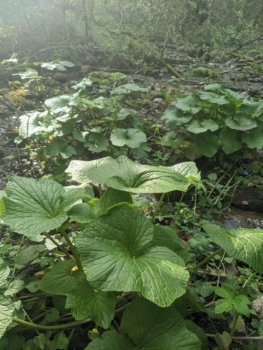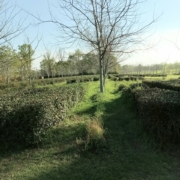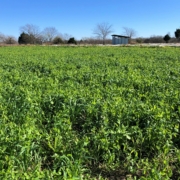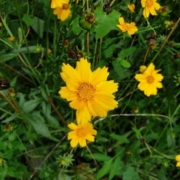Wasabi—A Unique Plant in a Unique Place
 Print This Post
Print This Post
By Danielle Crocker, NCAT Agriculture Specialist
Early in my farming journey, I started to look at every unique spot on my property as an opportunity to grow something site-specific. Fortunately, I had a small creek on the “back forty.” This creek boasted a perennial seep that poured consistently into the creek. A seep is a place where groundwater percolates to the surface due to the area’s geology. They are typically found along slopes and slowly drain towards a creek or wetland. Unlike the creek, the seep remained unchanged after a heavy rain. The seep was naturally sandy and speckled with pebbles and the occasional box turtle. After planting a few pawpaws alongside the creek, I thought there had to be something that would benefit from that soggy, sandy seep. That is when I discovered Joe Hollis and his Mountain Gardens of North Carolina. I discovered he was growing a nondescript variety of Wasabi in Burnsville, North Carolina. This ignited my flame of wasabi curiosity!
You might be wondering how a state known for humid summers and pine trees could possibly be good for wasabi. Well, it turns out our lovely mountains, particularly in the western part of the state, can provide micro-climates similar to wasabi’s native habitats in Japan.

Year 1: Tissue culture wasabi plants by Danielle Crocker.
Shade and nutrient-rich water or moist/nutrient-rich soil is an absolute requirement. A northern exposure out of direct sun is ideal. The optimal temperature for the whole growing season is 50 to 60°F. Wasabi is native to areas that have hot, humid summers and dry, cool winters. Western North Carolina temperatures typically fit this wasabi requirement for 75% of the year. When temperatures reach the 80s to 90s, the shade and cool water humidity help keep the area slightly cooler than the ambient temperature. It was risky, but I doubled down on experimenting with wasabi due to the high-value potential for a small farmer. Plus, I thought it would be really cool to try.

Year 2: Seep-grown wasabi by Danielle Crocker.
I began with 30 tissue-cultured plants (sourced online) to ensure healthy vigor. I prepped the sandy, seep bed with pea gravel for extra stability. I planted three cultivars in the fall: Green Thumb, Daruma, and Mazuma. After one year, I discovered the Daruma thrived, Green Thumb survived, and Mazuma failed. I generally neglected them since planting, in hopes they would self-seed. They did not. I have seen these plants make seeds, but never evidence of a new plant outside of the original rhizome. Rhizomes are horizontal, underground plant stems that can produce shoots and roots. These sturdy rhizomes are the part used for wasabi, technically not the roots. As the plant produces more rhizomes each year, I break off rhizomes and can create more plants that are genetically the same as the parent plant. It’s a beautiful cycle of wasabi generosity.
To be fair, growing wasabi isn’t exactly a fast-food affair. These plants take their sweet time—around 18 months to two years before you can harvest their prized rhizomes. But once you do, you’ll be able to impress (and maybe even confuse) your neighbors with fresh, real wasabi that tastes worlds apart from that neon green horseradish stuff at sushi joints.
So next time you’re slogging through that wet spot in your backyard, don’t see it as a nuisance. Maybe see it as untapped potential for your future wasabi patch. With a bit of patience, you could be on your way to growing a crop that’s as unexpected in North Carolina as snow in July. And who knows? You might just start a new trend: North Carolina seeps—the secret to the perfect sushi.
Related ATTRA Resources:
Other Resources:
Can I Grow Wasabi in Western North Carolina?
Growing Wasabi in Western North Carolina-2002 Report
How to Grow Wasabi in Your Garden
Our Specialties — Mountain Gardens
Wasabi – Eutrema japonicum, North Carolina Extension Gardener Plant Toolbox
Growing Wasabi in the Pacific Northwest
This blog is produced by the National Center for Appropriate Technology through the ATTRA Sustainable Agriculture program, under a cooperative agreement with USDA Rural Development. ATTRA.NCAT.ORG.











